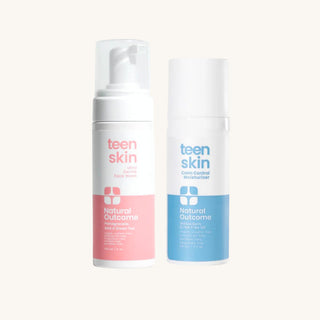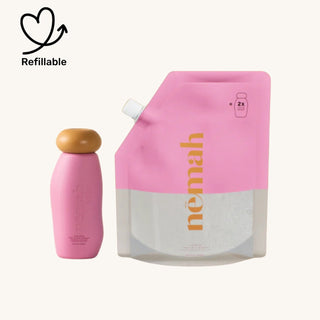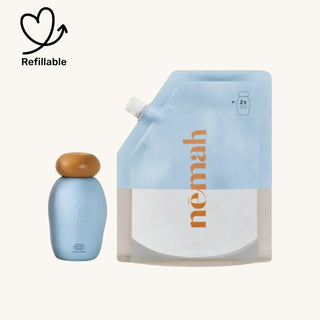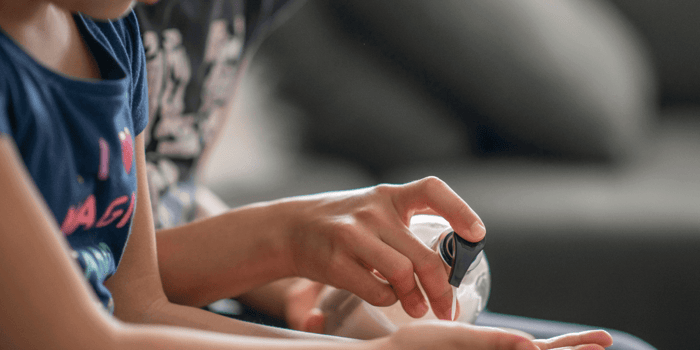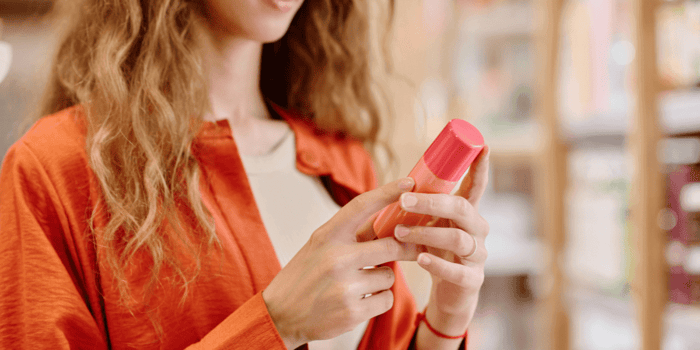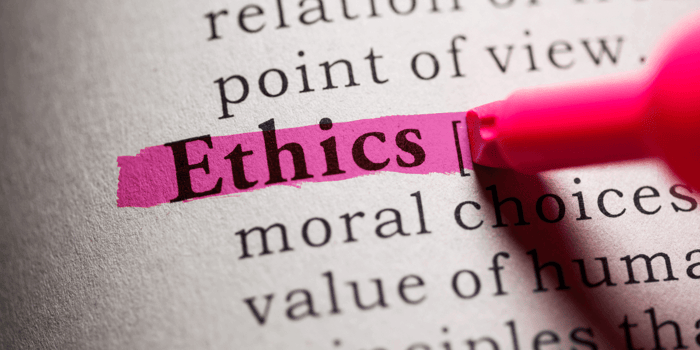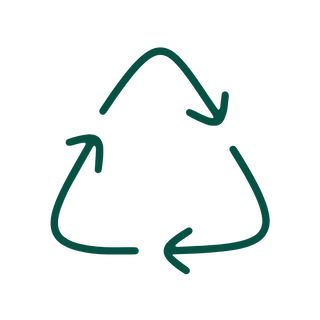What To Expect In This Blog Post
Introduction
- Why kids need a different skincare approach than adults.
- The dangers of synthetic chemicals in mainstream kids' skincare.
- What makes skincare truly non-toxic for children?
Section 1: Why Skincare for Kids Needs to Be Different
🔹 1.1 How Children's Skin is Different from Adults’
- Thinner, more absorbent skin means toxins penetrate more easily.
- Higher sensitivity to harsh chemicals, artificial fragrances, and preservatives.
- Developing skin barrier means hydration and gentle cleansing are key.
🔹 1.2 When Should Kids Start a Skincare Routine?
- Simple cleansing & moisturizing can begin as early as age 4-6.
- Tweens (8-12) may need more structured routines as hormones change.
- Prevention is better than treatment—start with clean, gentle products early.
Section 2: Harmful Ingredients to Avoid in Kids' Skincare
🔹 2.1 Toxic Chemicals Commonly Found in Children's Skincare
- Parabens & Phthalates – Linked to hormone disruption.
- Synthetic Fragrances – Can trigger allergies & skin irritation.
- Sulfates (SLS & SLES) – Harsh cleansers that strip natural oils.
- Formaldehyde-Releasing Preservatives – Used to extend shelf life but harmful to health.
🔹 2.2 How to Spot Greenwashing on Labels
- "Natural" doesn’t always mean safe—brands often use it as a marketing gimmick.
- Check for certifications like EWG Verified™, USDA Organic, and Made Safe®.
- Look beyond the front packaging and read the full ingredient list.
Section 3: The Best Safe & Non-Toxic Skincare Products for Kids
🔹 3.1 The Best Kid-Friendly Face Washes
- Gentle cleansers that don’t strip natural oils.
- Foaming vs. gel vs. cream cleansers—which one is best for kids?
- Top brands that avoid sulfates & synthetic fragrances.
🔹 3.2 The Best Moisturizers for Kids
- What makes a good moisturizer for children’s skin?
- Best hydrating ingredients (aloe vera, jojoba oil, shea butter).
- What to avoid (mineral oil, synthetic emulsifiers, petroleum-based ingredients).
🔹 3.3 Sunscreen: A Must-Have for Kids' Skincare
- Why daily SPF is important even for kids.
- Physical (mineral) vs. chemical sunscreens—which is safer?
- How to choose non-toxic, reef-safe SPF for kids.
Section 4: Creating a Simple & Natural Skincare Routine for Tweens
🔹 4.1 How to Introduce a Skincare Routine
- The importance of keeping it simple—no 10-step routines!
- Teaching kids about cleansing, moisturizing, and sun protection.
- Making skincare a fun, stress-free habit.
🔹 4.2 The 3-Step Routine for Tweens
Step 1: Gentle Cleansing (best face washes for tweens).
Step 2: Hydration & Moisturizing (lightweight, natural ingredients).
Step 3: Daily Sun Protection (choosing the best mineral SPF).
Section 5: DIY Natural Skincare Recipes for Kids
🔹 5.1 Why DIY Skincare is a Great Option
- No hidden chemicals or preservatives—100% natural.
- Budget-friendly and customizable for different skin types.
- A fun, educational activity for parents & kids to do together.
🔹 5.2 Easy DIY Skincare Recipes
🧼 Gentle Oatmeal & Honey Cleanser (for sensitive skin).
💧 Aloe Vera & Chamomile Face Mist (calms irritation).
🌿 Shea Butter & Jojoba Oil Moisturizer (lightweight hydration).
Conclusion: Raising Kids with Healthy Skincare Habits
- Why starting early with safe skincare builds lifelong habits.
- How to teach kids to read labels and choose better products.
- Where to find truly non-toxic skincare for kids.
Introduction: Why Kids Need Safe & Non-Toxic Skincare
Children’s skin is thinner, more absorbent, and more sensitive than adult skin, making it far more vulnerable to harsh chemicals and synthetic ingredients found in many mainstream skincare products. While parents are often careful about what their kids eat, many don’t realize that what goes on their skin is just as important. Harmful ingredients like parabens, synthetic fragrances, sulfates, and artificial dyes can penetrate a child’s delicate skin, potentially leading to irritation, allergies, and long-term health concerns.
So how do you choose gentle, natural, and truly non-toxic skincare for kids? With so many products labeled as “natural” or “hypoallergenic”, it’s easy to assume they’re safe—but the truth is, many of these claims are just marketing tactics. The key is to understand which ingredients to avoid, what makes a skincare product truly safe, and how to build a simple, effective routine for your child.
This guide will walk you through everything you need to know about non-toxic skincare for kids, including the best gentle cleansers and moisturizers, harmful ingredients to steer clear of, and even DIY skincare recipes you can make at home. Whether you're looking to start a simple natural skincare routine for your tween or just want to ensure your child’s skin stays healthy and irritation-free, this guide has got you covered.
Section 1: Why Skincare for Kids Needs to Be Different
Many parents assume that skincare is one-size-fits-all, but children’s skin is fundamentally different from adult skin in several key ways. Kids have a weaker skin barrier, meaning their skin absorbs ingredients more easily and is less equipped to defend against irritants and environmental toxins. This makes them more vulnerable to harsh cleansers, synthetic preservatives, and artificial fragrances, which can cause dryness, irritation, and even long-term health concerns.
Because a child’s skin naturally produces more hydration and oils than an adult’s, they don’t need the same intensive skincare routines that teens and adults do. In fact, using too many products or overly harsh ingredients can actually disrupt the skin’s natural balance, leading to redness, sensitivity, or breakouts. That’s why the focus of kid-friendly skincare should be on gentle cleansing, light hydration, and sun protection, rather than complicated multi-step routines.
When Should Kids Start a Skincare Routine?
Most children don’t need a structured skincare routine at a young age, but teaching them the basics early can help build lifelong healthy habits. Kids as young as 4-6 years old can start with a simple, gentle cleanser to wash away dirt and sweat, especially if they’re active or frequently play outdoors. By the time kids reach the tween years (8-12 years old), their skin may start producing more oil, making it a good time to introduce a mild moisturizer and non-toxic sunscreen for added protection.
The goal is to keep it simple and avoid overwhelming kids with too many steps or unnecessary products. A basic, safe routine should include:
- A mild, sulfate-free cleanser to remove dirt without stripping natural oils
- A lightweight, non-toxic moisturizer to keep skin balanced
- A mineral-based sunscreen to protect from sun damage
By starting with these fundamental steps, kids can maintain healthy, irritation-free skin without exposure to harsh or unnecessary chemicals.
🔗 Related: How To Create An Easy Daily Skincare Routine For Kids
Section 2: Harmful Ingredients to Avoid in Kids’ Skincare
Many skincare products marketed for children contain hidden toxins, harsh preservatives, and synthetic chemicals that can irritate their delicate skin. While brands often use words like "gentle," "natural," or "hypoallergenic", these terms are not legally regulated, meaning they don’t always guarantee safety. To truly protect your child’s skin, it’s important to look beyond the front label and carefully examine the ingredient list.
Some of the most common harmful ingredients in kids’ skincare include parabens, sulfates, synthetic fragrances, and petroleum-based ingredients. These chemicals may be used to extend shelf life, create foaming textures, or add artificial scents, but they can also cause skin irritation, allergies, and even long-term health effects. Below, we break down the most concerning ingredients and what to use instead.
🚨 1. Parabens (Methylparaben, Propylparaben, Butylparaben)
Parabens are commonly used preservatives that help prevent mold and bacteria from growing in skincare products. However, they are also known as endocrine disruptors, meaning they can mimic estrogen in the body and interfere with hormone function. Studies have linked parabens to early puberty, hormone imbalances, and potential fertility concerns later in life.
🛑 How to spot it: Look for ingredients ending in “-paraben” (e.g., methylparaben, ethylparaben).
💡 Safer alternative: Products preserved with natural vitamin E (tocopherol), fermented radish root extract, or rosemary extract.
🚨 2. Sulfates (Sodium Lauryl Sulfate & Sodium Laureth Sulfate – SLS & SLES)
Sulfates are foaming agents found in many cleansers, shampoos, and bubble baths. While they create a satisfying lather, they are also harsh detergents that strip the skin of its natural protective oils, leading to dryness, irritation, and even eczema flare-ups. For children with sensitive skin, sulfates can cause redness, itching, and long-term disruption of the skin barrier.
🛑 How to spot it: Look for Sodium Lauryl Sulfate (SLS) or Sodium Laureth Sulfate (SLES) in ingredient lists.
💡 Safer alternative: Use coconut-based cleansers like coco-glucoside or decyl glucoside, which clean without over-drying.
🚨 3. Synthetic Fragrances & Artificial Dyes
Many kids' skincare products contain synthetic fragrances and artificial colorants to make them more appealing. However, these ingredients often include undisclosed chemicals, some of which have been linked to hormone disruption, allergies, and skin irritation. Artificial dyes, particularly Red 40, Yellow 5, and Blue 1, have also been associated with hyperactivity in children.
🛑 How to spot it: Look for "Fragrance," "Parfum," or artificial dyes (FD&C Red 40, D&C Blue 1) in the ingredient list.
💡 Safer alternative: Choose products scented with real fruit extracts or essential oils and colored with natural plant-based pigments like beetroot powder or spirulina.
🔗 Related: Red Dye No. 3: A Step in the Right Direction, But Is It Enough?
🚨 4. Petroleum-Based Ingredients (Mineral Oil, Petrolatum, Paraffin Wax)
Petroleum-based ingredients are commonly found in moisturizers, lip balms, and diaper creams because they create a protective barrier on the skin. However, they don’t actually provide hydration—they just seal the skin, preventing it from breathing. Worse, these ingredients can sometimes be contaminated with carcinogenic byproducts like polycyclic aromatic hydrocarbons (PAHs).
🛑 How to spot it: Look for Mineral Oil, Petrolatum, or Paraffin Wax in ingredient lists.
💡 Safer alternative: Opt for plant-based moisturizers with shea butter, cocoa butter, or jojoba oil, which provide hydration and nourishment without clogging pores.
🚨 5. Formaldehyde-Releasing Preservatives (DMDM Hydantoin, Quaternium-15, Diazolidinyl Urea)
Formaldehyde is a known carcinogen, yet some kids’ skincare products still contain formaldehyde-releasing preservatives that slowly release small amounts of formaldehyde over time. These preservatives are used to prevent bacterial growth, but they have been linked to skin irritation, allergic reactions, and respiratory issues.
🛑 How to spot it: Look for DMDM Hydantoin, Quaternium-15, Diazolidinyl Urea, or Imidazolidinyl Urea on labels.
💡 Safer alternative: Choose products preserved with fermented extracts, radish root ferment, or sodium benzoate.
🚨 6. Phenoxyethanol (A Hidden Paraben Alternative)
Many brands advertise “paraben-free” skincare but secretly replace parabens with phenoxyethanol, another synthetic preservative linked to skin irritation, nervous system toxicity, and potential organ damage in high doses. While it’s often used in natural brands, recent studies suggest it may not be as safe as once believed.
🛑 How to spot it: Look for Phenoxyethanol near the end of the ingredient list.
💡 Safer alternative: Opt for products preserved with natural antioxidants like vitamin C or rosemary extract.
Final Thoughts on Harmful Ingredients
Many mainstream skincare brands prioritize profits over safety, using cheap synthetic ingredients instead of gentle, natural alternatives. The best way to protect your child’s skin is to read labels carefully, research ingredients, and choose brands that prioritize transparency and safety.
Whenever possible, opt for simple, plant-based skincare products that are free from parabens, sulfates, artificial fragrances, and petroleum-based ingredients. By making informed choices now, you can help your child develop healthy skincare habits that last a lifetime.
🔗 Related: Choosing Safe Skincare Products For Kids: A Quick Guide
Section 3: The Best Safe & Non-Toxic Skincare Products for Kids
With so many skincare products marketed as "natural" or "gentle," it can be overwhelming for parents to determine which options are truly safe and non-toxic for their child’s delicate skin. Many brands still use hidden synthetic chemicals, petroleum-based ingredients, and artificial fragrances, even when they advertise themselves as clean. The key is to look for transparent ingredient lists, third-party certifications, and formulations free from harsh chemicals.
In this section, we’ll cover the best kid-friendly cleansers, moisturizers, and sunscreens, focusing on products that are effective, gentle, and free from harmful toxins.
🔹 3.1 The Best Kid-Friendly Face Washes
Choosing the right face wash for kids is essential because harsh cleansers can strip away natural oils, leading to dryness, irritation, and an imbalanced skin barrier. Many commercial face washes contain sulfates (SLS/SLES), synthetic dyes, and parabens, which can trigger allergies and skin sensitivities. Instead, opt for mild, sulfate-free cleansers that gently remove dirt and excess oil without disrupting the skin’s natural moisture balance.
A good kid-friendly cleanser should:
✔️ Be fragrance-free or naturally scented with essential oils
✔️ Contain gentle, plant-based surfactants instead of sulfates
✔️ Include calming ingredients like chamomile, aloe vera, or oat extract
When introducing a cleansing routine, start by teaching your child to wash their face once a day, preferably in the evening, to remove dirt and sweat from the day. This prevents clogged pores and keeps their skin fresh without over-cleansing.
🔗 Related: What Should Your Child Be Using: Face Wash Or Face Cleanser?
🔹 3.2 The Best Moisturizers for Kids
A good moisturizer helps protect a child’s skin by maintaining hydration without clogging pores or feeling heavy. Many conventional moisturizers contain petroleum-based ingredients (mineral oil, paraffin) and synthetic preservatives, which can create an artificial barrier without providing real nourishment. Instead, look for formulas made with plant-based butters and oils, which naturally support and strengthen the skin barrier.
The best kid-friendly moisturizers contain:
✔️ Aloe vera – Soothes and hydrates sensitive skin
✔️ Shea butter & cocoa butter – Deeply nourishes without clogging pores
✔️ Jojoba oil & squalane – Mimic natural skin oils for light hydration
Since kids' skin is naturally well-hydrated, a moisturizer should only be used as needed, particularly during dry seasons or after sun exposure. For tweens with slightly oilier skin, a lightweight, non-greasy formula is best.
🔹 3.3 Sunscreen: A Must-Have for Kids' Skincare
Sunscreen is one of the most important steps in a child’s skincare routine, as early sun protection prevents long-term skin damage and reduces the risk of skin cancer later in life. However, many sunscreens contain chemical UV filters (oxybenzone, octinoxate, homosalate), which have been linked to hormone disruption and skin irritation.
For kids, always choose mineral-based sunscreens with:
✔️ Zinc oxide or titanium dioxide – Provide broad-spectrum protection without chemical absorption
✔️ Non-nano formulas – Avoids nanoparticles that can be inhaled or absorbed into the bloodstream
✔️ Fragrance-free & reef-safe ingredients – Gentle on the skin and the environment
It’s also important to teach kids how to apply sunscreen properly—applying a generous amount 15 minutes before sun exposure and reapplying every two hours, especially after swimming or sweating.
🔹 3.4 How to Choose Safe Skincare Brands for Kids
When shopping for skincare, it's important to choose brands that prioritize ingredient transparency and avoid greenwashing tactics. Some brands claim to be "natural" but still contain hidden synthetic preservatives, artificial colors, or undisclosed fragrance blends.
To find truly non-toxic skincare brands for kids, look for:
✔️ EWG VERIFIED™ – Meets strict safety standards for clean ingredients
✔️ USDA Organic Certification – Indicates ingredients are grown without pesticides or synthetic chemicals
✔️ Made Safe® Certification – Ensures the product is free from known toxic ingredients
✔️ Ingredient lists with full transparency – Avoid brands that hide ingredients under vague terms like “fragrance” or “preservatives”
By choosing safe skincare brands, parents can ensure their child’s skin is protected from harsh chemicals while still receiving effective, gentle care.
🔗 Related: Your Ultimate Guide to Free Tools for Clean Living
Final Thoughts on Choosing the Best Skincare for Kids
The key to safe skincare for kids is simplicity. Their skin doesn’t need complicated routines or harsh treatments—just gentle cleansing, occasional moisture, and daily sun protection. By avoiding toxic ingredients, choosing plant-based alternatives, and reading labels carefully, parents can build a healthy skincare routine that supports their child’s natural skin barrier.
Section 4: Creating a Simple & Natural Skincare Routine for Tweens
As kids enter their tween years (ages 8-12), their skin begins to change. Increased outdoor activities, exposure to environmental pollutants, and the early stages of hormonal shifts can lead to oilier skin, occasional breakouts, or dryness. While young children don’t need an elaborate skincare routine, tweens can benefit from a simple, non-toxic regimen that encourages healthy habits without overwhelming them.
A skincare routine for tweens should be easy, quick, and focused on skin health rather than beauty. Many mainstream brands market strong acne treatments, anti-aging serums, and deep cleansers to young audiences, but these products are often too harsh and unnecessary at this stage. Instead, parents should introduce a basic 3-step routine that keeps skin balanced, protected, and free from irritation.
🔹 4.1 How to Introduce a Skincare Routine to Tweens
When introducing a skincare routine, the key is to make it fun and simple. Instead of presenting it as a “chore,” frame it as an act of self-care—similar to brushing teeth or taking a bath. Many tweens are naturally curious about skincare, especially if they see their parents or older siblings using products, so it’s a great opportunity to teach them about healthy skin habits early on.
A tween-friendly skincare routine should:
✔️ Be simple – No more than 3 steps: cleanse, moisturize, and protect.
✔️ Use gentle, non-toxic products – Avoid harsh exfoliants, strong acne treatments, and synthetic ingredients.
✔️ Encourage consistency – Make skincare a daily habit without overcomplicating it.
🔹 4.2 The 3-Step Routine for Tweens
A good tween skincare routine should focus on basic hygiene, hydration, and sun protection. Here’s what that looks like:
🧼 Step 1: Gentle Cleansing (Morning & Night)
Tweens should start and end their day by washing their face with a mild cleanser. Since their skin is still developing its natural oil balance, over-cleansing can lead to dryness or irritation. A sulfate-free, plant-based cleanser is ideal for removing sweat, dirt, and buildup without stripping the skin.
Best cleansing tips for tweens:
- Wash twice a day (morning & night) using lukewarm water.
- Use a gentle, non-foaming cleanser with aloe, chamomile, or oat extract.
- Avoid scrubbing too hard, as this can irritate the skin.
💧 Step 2: Lightweight Hydration (As Needed)
Not all tweens need a daily moisturizer, but some may experience dryness, especially after cleansing. The key is to use a non-greasy, fragrance-free moisturizer that nourishes the skin without clogging pores.
Best moisturizing tips for tweens:
- Apply only when needed (morning or night) to prevent over-hydration.
- Choose a plant-based formula with jojoba oil, shea butter, or squalane.
- Avoid heavy creams containing mineral oil, silicones, or synthetic fragrances.
☀️ Step 3: Sun Protection (Every Morning)
Sunscreen is the most important skincare step for kids and tweens. Daily exposure to UV rays causes long-term damage, and childhood sunburns increase the risk of skin cancer later in life. Since many commercial sunscreens contain harmful chemical filters (oxybenzone, octinoxate, homosalate), it’s best to choose a mineral-based SPF that sits on the skin rather than absorbing into the bloodstream.
Best sunscreen tips for tweens:
- Choose a broad-spectrum SPF 30+ with zinc oxide or titanium dioxide.
- Apply every morning, even on cloudy days.
- Reapply every 2 hours when outdoors or after swimming.
🔹 4.3 Avoiding Skincare Mistakes & Common Myths
Many tweens are influenced by social media trends, leading them to use harsh acne treatments, sheet masks, or exfoliating scrubs before they actually need them. To keep their routine safe and effective, parents should:
🛑 Avoid harsh acne products unless recommended by a dermatologist.
🛑 Teach them to read ingredient labels to spot hidden toxins.
🛑 Remind them that skincare is for skin health, not beauty standards.
With guidance, tweens can build healthy skincare habits that will benefit them for life—without the pressure of unrealistic beauty expectations.
🔗 Related: The Science & Ethics Behind Non-Toxic Beauty
Final Thoughts on Tween Skincare Routines
A non-toxic skincare routine should be simple, effective, and tailored to a child’s natural skin needs. By choosing gentle products, avoiding harmful ingredients, and teaching tweens to care for their skin properly, parents can ensure their kids develop healthy habits that last a lifetime.
Section 5: DIY Natural Skincare Recipes for Kids
Making homemade skincare products is a great way to ensure your child’s routine is 100% safe and free from toxic ingredients. Many store-bought skincare products contain hidden chemicals, synthetic fragrances, and artificial dyes, even when marketed as “natural.” With DIY skincare, you have complete control over what goes on your child’s skin, while also making it a fun, educational activity.
Natural skincare doesn’t have to be complicated—many safe and effective homemade cleansers, moisturizers, and masks can be made with simple, plant-based ingredients like oats, aloe vera, coconut oil, and fruit extracts. These ingredients are not only gentle and nourishing, but they also help children learn healthy skincare habits from an early age.
🔹 5.1 Why DIY Skincare is Great for Kids
Many parents worry about the safety of commercial skincare products, but DIY skincare offers several key benefits:
✔️ No hidden chemicals – Free from parabens, sulfates, artificial dyes, and preservatives.
✔️ Gentle on sensitive skin – Uses mild, plant-based ingredients instead of harsh additives.
✔️ Teaches kids about self-care – Helps them understand what ingredients nourish their skin.
✔️ Budget-friendly & sustainable – Reduces plastic waste and unnecessary packaging.
Homemade skincare is also a great way to involve kids in self-care without exposing them to beauty industry pressures. Instead of focusing on appearance, DIY skincare can be framed as a fun, sensory experience that promotes wellness and creativity.
🔹 5.2 Easy DIY Skincare Recipes for Kids
Here are three simple, non-toxic recipes that use safe, food-grade ingredients to gently cleanse, hydrate, and soothe your child’s skin.
🧼 1. Gentle Oatmeal & Honey Face Cleanser (For Sensitive Skin)
Many store-bought face washes contain sulfates and synthetic foaming agents, which can strip the skin of its natural protective oils. This DIY oatmeal cleanser is soap-free and perfect for kids with sensitive or dry skin.
🌱 Ingredients:
- 2 tbsp finely ground oats (colloidal oatmeal)
- 1 tbsp raw honey (antibacterial & soothing)
- 1 tbsp chamomile tea (calms redness & irritation)
📝 Instructions:
- Blend oats into a fine powder using a food processor.
- Mix with honey and chamomile tea until a smooth paste forms.
- Apply to the face in gentle circular motions, then rinse with warm water.
💡 Why it works: Oats gently cleanse while honey acts as a natural humectant, keeping skin hydrated and soft.
💧 2. Aloe Vera & Jojoba Oil Moisturizer (Lightweight & Hydrating)
Most commercial moisturizers for kids contain petroleum-based ingredients that sit on the skin instead of truly hydrating it. This DIY lightweight moisturizer absorbs quickly and nourishes the skin without clogging pores.
🌱 Ingredients:
- 2 tbsp pure aloe vera gel (hydrating & soothing)
- 1 tsp jojoba oil (closest to skin’s natural oils)
- 2 drops lavender essential oil (optional, for calming scent)
📝 Instructions:
- Whisk all ingredients together in a small bowl.
- Store in a small container and use within two weeks.
- Apply a pea-sized amount to the skin as needed.
💡 Why it works: Aloe vera hydrates and cools the skin, while jojoba oil locks in moisture without feeling greasy.
🍓 3. Berry & Yogurt Face Mask (Brightening & Nourishing)
Instead of using chemical-laden face masks, try this all-natural, antioxidant-rich mask that gently nourishes the skin and makes for a fun, sensory experience.
🌱 Ingredients:
- 3 fresh strawberries (rich in vitamin C & antioxidants)
- 1 tbsp plain yogurt (exfoliates with natural lactic acid)
- 1 tsp honey (hydrates & soothes the skin)
📝 Instructions:
- Mash the strawberries with a fork until smooth.
- Mix in yogurt and honey until well combined.
- Apply to the face for 5-10 minutes, then rinse off with warm water.
💡 Why it works: Strawberries provide natural exfoliation and brightening, while yogurt gently dissolves dead skin cells.
🔹 5.3 How to Store DIY Skincare Products Safely
Since DIY skincare products don’t contain synthetic preservatives, they have a shorter shelf life than commercial options. To keep them fresh and safe:
🛑 Store in airtight containers in the fridge when possible.
🛑 Use within 1-2 weeks to prevent bacterial growth.
🛑 Always use clean hands or a spatula to scoop out the product.
If your child has extremely sensitive skin or known allergies, always patch-test a small amount of any DIY product before applying it to their face.
Final Thoughts on DIY Skincare for Kids
DIY skincare is a great way to introduce kids to safe, natural ingredients while avoiding harmful chemicals and synthetic additives. By making simple cleansers, moisturizers, and masks at home, parents can ensure their child’s skincare routine is truly non-toxic, fun, and effective.
Plus, these recipes allow kids to explore self-care in a playful, creative way without being influenced by beauty industry marketing and unrealistic standards. Whether it’s mashing up fruit for a face mask or mixing honey into an oat cleanser, these small moments help kids connect with natural skincare in a way that feels fun and empowering.
🔗 Related: DIY Natural Skin Care Recipes: Perfect For A Family Spa Day
Conclusion: Raising Kids with Healthy Skincare Habits
Teaching kids about safe, non-toxic skincare isn’t just about protecting their skin today—it’s about setting them up for a lifetime of healthy habits. With so many mainstream products containing hidden chemicals, synthetic fragrances, and misleading marketing claims, it’s crucial for parents to look beyond labels and choose products that are truly gentle, effective, and toxin-free. By prioritizing simple, plant-based ingredients, avoiding harmful additives, and establishing a basic skincare routine, we can help kids care for their skin in a way that is natural, safe, and appropriate for their age. Whether you choose trusted non-toxic brands or explore fun DIY skincare recipes, the goal is the same—to encourage confidence, self-care, and an understanding that skincare is about wellness, not unrealistic beauty standards. As kids grow, their skincare needs will change, but with a strong foundation of safe habits and mindful choices, they’ll be empowered to make informed decisions about what goes on their skin for years to come.



